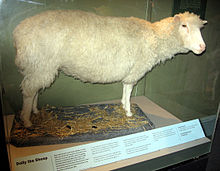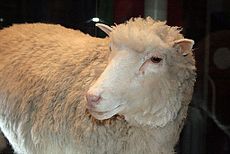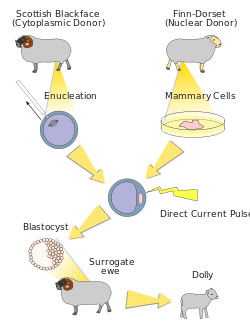- Dolly (sheep)
-
Dolly (sheep) 
Dolly's remains, exhibited at the Museum of Scotland.Species domestic sheep Sex female Born 5 July 1996 Died 14 February 2003 [aged 6] Resting Place - in The Museum Nation from Scotland Years active 1996 - 2003 Notable role First cloned sheep Known for First mammal to be cloned from an adult somatic cell Children Six lambs (bonnie, twins - sally and rosie, triplets - lucy, darcy, cotton) Dolly (5 July 1996 – 14 February 2003) was a female domestic sheep, and the first mammal to be cloned from an adult somatic cell, using the process of nuclear transfer.[1][2] She was cloned by Ian Wilmut, Keith Campbell and colleagues at the Roslin Institute near Edinburgh in Scotland. She was born on 5 July 1996 and she lived until the age of six; unfortunately she suffered from a progressive lung disease.[3] She has been called "the world's most famous sheep" by sources including BBC News and Scientific American.[4][5] The cell used as the donor for the cloning of Dolly was taken from a mammary gland, and the production of a healthy clone therefore proved that a cell taken from a specific part of the body could recreate a whole individual. On Dolly's name, Wilmut stated "Dolly is derived from a mammary gland cell and we couldn't think of a more impressive pair of glands than Dolly Parton's".[6]
Contents
Birth
Dolly was born 5 July 1996 to three mothers (one provided the egg, another the DNA and a third carried the cloned embryo to term).[7] She was created using the technique of somatic cell nuclear transfer, where the cell nucleus from an adult cell is transferred into an unfertilised oocyte (developing egg cell) that has had its nucleus removed. The hybrid cell is then stimulated to divide by an electric shock, and when it develops into a blastocyst it is implanted in a surrogate mother.[8] Dolly was the first clone produced from a cell taken from an adult mammal. The production of Dolly showed that genes in the nucleus of such a mature differentiated somatic cell are still capable of reverting back to an embryonic totipotent state, creating a cell that can then go on to develop into any part of an animal.[9] Dolly's existence was announced to the public on 22 February 1997.[3]
Life
Dolly lived for her entire life at the Roslin Institute in Edinburgh. There she was bred with a Welsh Mountain ram and produced six lambs in total. Her first lamb, named Bonnie, was born in April 1998.[3] The next year Dolly produced twin lambs Sally and Rosie, and she gave birth to triplets Lucy, Darcy and Cotton in the year after that.[10] In the autumn of 2001, at the age of four, Dolly developed arthritis and began to walk stiffly, but this was successfully treated with anti-inflammatory drugs.[11]
Death
On 14 February 2003, Dolly was euthanised because she had a progressive lung disease and severe arthritis.[12] A Finn Dorset such as Dolly has a life expectancy of around 11 to 12 years, but Dolly lived to be only six years of age. A post-mortem examination showed she had a form of lung cancer called Jaagsiekte,[13] which is a fairly common disease of sheep and is caused by the retrovirus JSRV.[14] Roslin scientists stated that they did not think there was a connection with Dolly being a clone, and that other sheep in the same flock had died of the same disease.[12] Such lung diseases are a particular danger for sheep kept indoors, and Dolly had to sleep inside for security reasons.
Some have speculated that a contributing factor to Dolly's death was that she could have been born with a genetic age of six years, the same age as the sheep from which she was cloned.[15] One basis for this idea was the finding that Dolly's telomeres were short, which typically is a result of the ageing process.[16][17] The Roslin Institute have stated that intensive health screening did not reveal any abnormalities in Dolly that could have come from advanced ageing.[15]
Legacy
After cloning was successfully demonstrated through the production of Dolly, many other large mammals have been cloned, including horses and bulls.[18] The attempt to clone argali (mountain sheep) did not produce viable embryos. The attempt to clone a banteng bull was more successful, as were the attempts to clone mouflon (a form of wild sheep), both resulting in viable offspring.[19] The reprogramming process cells need to go through during cloning is not perfect and embryos produced by nuclear transfer often show abnormal development.[20][21] making cloning mammals highly inefficient (Dolly was the only lamb that survived to adulthood from 277 attempts). Wilmut, who led the team that created Dolly, announced in 2007 that the nuclear transfer technique may never be sufficiently efficient for use in humans.[22]
Cloning may have uses in preserving endangered species and may become a viable tool for reviving extinct species.[23] In January 2009, scientists from the Centre of Food Technology and Research of Aragon, in Zaragoza, northern Spain announced the cloning of the Pyrenean ibex, a form of wild mountain goat, which was officially declared extinct in 2000. Although the newborn ibex died shortly after birth due to physical defects in its lungs it is the first time an extinct animal has been cloned, and may open doors for saving endangered and newly extinct species by resurrecting them from frozen tissue.[24] Cloning does not introduce new genes into a population so will not increase genetic diversity.[25] Cloning of domesticated animals could be important in the future production of transgenic livestock.[26]
References
- ^ McLaren A (2000). "Cloning: pathways to a pluripotent future". Science 288 (5472): 1775–80. doi:10.1126/science.288.5472.1775. PMID 10877698.
- ^ Wilmut I, Schnieke AE, McWhir J, Kind AJ, Campbell KH (1997). "Viable offspring derived from fetal and adult mammalian cells". Nature 385 (6619): 810–3. Bibcode 1997Natur.385..810W. doi:10.1038/385810a0. PMID 9039911.
- ^ a b c "Dolly the sheep clone dies young", BBC News, Friday, 14 February 2003
- ^ "Is Dolly old before her time?". BBC News (London). 27 May 1999. http://news.bbc.co.uk/1/hi/sci/tech/353617.stm. Retrieved 2009-10-04.
- ^ Lehrman, Sally (July 2008). "No More Cloning Around". Scientific American. http://www.sciam.com/article.cfm?id=no-more-cloning-around. Retrieved 2008-09-21.
- ^ "1997: Dolly the sheep is cloned". BBC News. 22 February 1997. http://news.bbc.co.uk/onthisday/hi/dates/stories/february/22/newsid_4245000/4245877.stm.
- ^ Nigel Williams (2003). "Death of Dolly marks cloning milestone". Current Biology 13 (6): 209–210. doi:10.1016/S0960-9822(03)00148-9. http://www.sciencedirect.com/science?_ob=ArticleURL&_udi=B6VRT-4861XN1-1&_user=2322062&_coverDate=03%2F18%2F2003&_rdoc=1&_fmt=high&_orig=search&_origin=search&_sort=d&_docanchor=&view=c&_searchStrId=1530903740&_rerunOrigin=scholar.google&_acct=C000056895&_version=1&_urlVersion=0&_userid=2322062&md5=e837053cf73ca882b9abaeb42810ba63&searchtype=a.
- ^ Campbell KH, McWhir J , Ritchie WA, Wilmut I (1996). "Sheep cloned by nuclear transfer from a cultured cell line". Nature 380 (6569): 64–6. Bibcode 1996Natur.380...64C. doi:10.1038/380064a0. PMID 8598906.
- ^ Niemann H, Tian XC, King WA, Lee RS (February 2008). "Epigenetic reprogramming in embryonic and foetal development upon somatic cell nuclear transfer cloning". Reproduction 135 (2): 151–63. doi:10.1530/REP-07-0397. PMID 18239046.
- ^ Dolly's family Roslin Institute, Accessed 21 February 2008 Cached version
- ^ Dolly's arthritis Roslin Institute, Accessed 21 February 2008 Cached version
- ^ a b Dolly's final illness Roslin Institute, Accessed 21 February 2008 Cached version
- ^ Bridget M. Kuehn Goodbye, Dolly; first cloned sheep dies at six years old American Veterinary Medical Association, 15 April 2003
- ^ Palmarini M (2007). "A Veterinary Twist on Pathogen Biology". PLoS Pathog. 3 (2): e12. doi:10.1371/journal.ppat.0030012. PMC 1803002. PMID 17319740. http://pathogens.plosjournals.org/perlserv/?request=get-document&doi=10.1371/journal.ppat.0030012.
- ^ a b Was Dolly already 'old' at birth? Roslin Institute, Accessed 4 April 2010
- ^ Shiels PG, Kind AJ, Campbell KH, et al (1999). "Analysis of telomere length in Dolly, a sheep derived by nuclear transfer". Cloning 1 (2): 119–25. doi:10.1089/15204559950020003. PMID 16218837. http://www.liebertonline.com/doi/abs/10.1089/15204559950020003.
- ^ Shiels PG, Kind AJ, Campbell KH, et al (1999). "Analysis of telomere lengths in cloned sheep". Nature 399 (6734): 316–7. Bibcode 1999Natur.399..316H. doi:10.1038/20577. PMID 10360570.
- ^ Lozano, Juan A. (27 June 2005). "A&M Cloning project raises questions still". Bryan-College Station Eagle. http://www.theeagle.com/stories/062705/am_20050627004.php. Retrieved 2007-04-30.
- ^ "Endangered sheep cloned". BBC News (London). 1 October 2001. http://news.bbc.co.uk/1/hi/sci/tech/1573309.stm. Retrieved 2007-11-12.
- ^ Jaenisch R, Hochedlinger K, Eggan K (2005). "Nuclear cloning, epigenetic reprogramming and cellular differentiation". Novartis Found. Symp.. Novartis Foundation Symposia 265: 107–18; discussion 118–28. doi:10.1002/0470091452.ch9. ISBN 9780470091456. PMID 16050253.
- ^ Rideout WM, Eggan K, Jaenisch R (August 2001). "Nuclear cloning and epigenetic reprogramming of the genome". Science 293 (5532): 1093–8. doi:10.1126/science.1063206. PMID 11498580.
- ^ Roger Highfield Dolly creator Prof Ian Wilmut shuns cloning Daily Telegraph 16 November 2007
- ^ Trounson AO (2006). "Future and applications of cloning". Methods Mol. Biol.. Methods in Molecular Biology 348: 319–32. doi:10.1007/978-1-59745-154-3_22. ISBN 978-1-58829-280-3. PMID 16988390. http://biomed.humanapress.com/ChapterDetail.pasp?medline=1-59745-154-1:319.
- ^ Gray, Richard; Dobson, Roger (31 January 2009). "Extinct ibex is resurrected by cloning". The Telegraph (London). http://www.telegraph.co.uk/science/science-news/4409958/Extinct-ibex-is-resurrected-by-cloning.html. Retrieved 2009-02-01.
- ^ Ehrenfeld, David (2006). "Transgenics and Vertebrate Cloning as Tools for Species Conservation". Conservation Biology 20 (3): 723–732. doi:10.1111/j.1523-1739.2006.00399.x. PMID 16909565.
- ^ "Texas A&M scientists clone world’s first deer". Innovations Report. 2003-12-23. http://www.innovations-report.de/html/berichte/biowissenschaften_chemie/bericht-24409.html. Retrieved 2007-01-01.
External links
- Dolly Stuffed on Display Video footage of Dolly the Sheep, stuffed in the Museum of Scotland, Edinburgh, UK
- Dolly the Sheep, 1996-2003 from the Science Museum, London
- Cloning - A life of Dolly from the Roslin Institute
- Dolly the Sheep at the National Museum of Scotland
- Animal cloning & Dolly
- Image library Photos of Dolly and other cloned animals at the Roslin Institute
Categories:- 1996 animal births
- 2003 animal deaths
- 1996 in Scotland
- Cloned animals
- Cloning
- Collections of the National Museums of Scotland
- Individual sheep
- History of Midlothian
Wikimedia Foundation. 2010.


